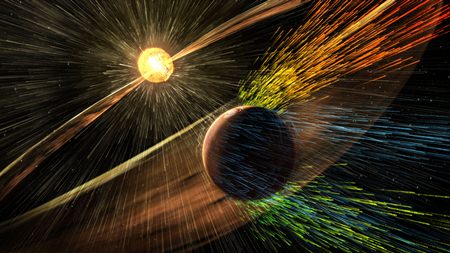Cape Canaveral, Fla. (AP) – NASA’s Mars-orbiting Maven spacecraft has discovered that the sun likely robbed the red planet of its once-thick atmosphere and water.
On Thursday, scientists reported that even today, the solar wind is stripping away about 100 grams of atmospheric gas every second. That’s about a quarter-pound a second lost to the stream of charged particles shooting away from the sun at 1 million mph (1.61 million kph).
 This image made available by NASA shows an artist’s rendering of a solar storm hitting the planet Mars and stripping ions from the planet’s upper atmosphere. (Goddard Space Flight Center/NASA via AP)
This image made available by NASA shows an artist’s rendering of a solar storm hitting the planet Mars and stripping ions from the planet’s upper atmosphere. (Goddard Space Flight Center/NASA via AP)
Big solar storms traveling at twice that speed increase the escape rate by 10 to 20 times – and more. Because of their prevalence billions of years ago, these storms would have been enough to gut the atmosphere of ancient Mars and transform it from a moist, warm place potentially capable of microscopic life to the cold, dry desert of today.
“I can’t help but imagine hamburgers flying out of the Martian atmosphere, one per second,” Maven scientist Dave Brain told reporters with a smile. “It’s instead oxygen and carbon dioxide that are leaving the planet, which are important both for water and for the climate of the planet overall.”
These latest Mars findings by robotic scouts such as Maven are a key part of NASA’s push to send human explorers to the red planet in the 2030s. Just over a month ago, the Mars Reconnaissance Orbiter revealed evidence of salt water trickling down Martian slopes, at least in the summer. NASA’s next mission begins in March with the launch of another orbiting explorer.
Principal scientist Bruce Jakosky and his team reported that during massive solar ejections of gas in March, the spacecraft noticed oxygen ions were flung higher into the atmosphere than expected. At the same time, streams of fast-moving magnetic activity shot 3,100 miles out into space.
That led the researchers to conclude Mars’ atmospheric decline may have been driven in large part by major solar events such as this, early in the planet’s history.
The atmosphere likely would have disappeared over a period of a few hundred-millions years. Mars no longer has a global magnetic field, but when it did 4 billion years ago, that would have prevented this wholesale loss of atmosphere, the researchers said. Earth’s strong magnetic field seals in our own atmosphere, preventing direct erosion by the solar wind.
Jakosky said further analysis will allow scientists to better define the atmospheric escape rate of ancient Mars. In any event, given the current loss, the existing thin atmosphere would be gone in another few billions of years, he noted, although the gas is also locked up in the polar caps and in the subsurface.
Jakosky and Brain work at the Laboratory for Atmospheric and Space Physics at the University of Colorado at Boulder.
Their findings appear in this week’s Science journal. The issue includes four studies conducted by the spacecraft, which has been circling Mars and studying its atmosphere for the past year. Maven, about the size of a school bus, was launched from Cape Canaveral in 2013.
Maven also was able to observe a Martian aurora thought to be in the same category as Earth’s northern lights. Researchers suspect the remnant magnetic field of Mars’ crust is driving the auroras.
Online:
NASA: http://mars.nasa.gov/maven/
Maven: http://lasp.colorado.edu/home/maven/




